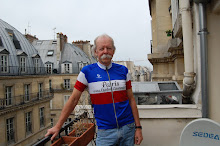One last look, from the kitchen into the garden.
And a look over to the side of the garden at a couple of ancient storage sheds.
They are storage sheds now but as originally constructed the one on the right with the ceramic pig was a pig house. The other was the outhouse.
We headed into Oxford Town. Oxford was first settled in Saxon times (before the Norman conquerors arrived). It began about AD900 as a place where oxen could ford the river.
The Normans built a castle shortly after the conquest (about 1070). In its earliest years it was an important military outpost but by about 1327 the castle was in poor repair. The castle was allowed to deteriorate. Eventually it found use as a prison.
Only a few bits remain, this is part of the outer wall and Saint George's Tower, FT for scale.
We headed on over to the academic part of town. This is Radcliffe Camera, built between 1737 and 1749 to house a science library.
The Radcliffe also served as a reading room for the Bodleian Library.
The Bodleian is the main research library of the University, one of the oldest libraries in Europe and the second largest library in Britain behind the only the British Library.
Down the walk from the Bodleian is Brasenose College, founded 1509.
David Cameron went there. So did Michael Palin.
Nearby is the University Church of Saint Mary the Virgin.
A church was established on this site, at the center of the old walled city in Anglo-Saxon times. In the early days of Oxford University, the church was adopted as the first building of the university, congregation met there from at least 1252 and by the early 13th century it was the seat of university government and was used for lectures and the awarding of degrees
An exterior view with the Radcliffe Camera on the right.
So this next part is kind of fun. You can't really find this place if you don't know at least a little bit. You have to know about the alley and where is leads. This is the very narrow alleyway known as St. Helen's Passage. Not everyone will know that there is a famous tavern down there.
Definitely not a street, probably only about 4 feet wide. Pedestrians only. But after a couple of turns you come to the Turf Tavern. It is an ancient old pub, claiming only to be ONE of the oldest in Oxford. We had lunch there at the back side of the garden. Here is the view from our table back towards the main establishment.
It is widely believed and the establishment even advertises that this is pretty much without doubt the spot where Bill Clinton did not inhale.
I know there is a subset of readers who like at least once in a while to see what the food looked like.
Pub food, two orders of fish and chips with peas, and a meat pie with gravy.
Out on Broad Street we came upon Christopher Wren's second work, the Sheldonian Theatre.
Built beginning in 1664, the Theatre was meant to provide the University with a separate building whose sole use would be graduation and degree ceremonies.Those occasions had become increasingly rowdy (we saw some evidence of that today) and the University wished to move those events away from where they had been previously held, the University's Church of St Mary the Virgin.
The roof of the building was a remarkable accomplishment for its time. The span of the D-shaped roof was over 70 feet. However, no timbers existed that were long enough to cross that distance. Wren decided to use a "geometrical flat floor" grid developed twenty years before by Oxford professor John Wallis. It involved creating a series of trusses which were built up from shorter sections and held in place by their own weight, with help from judiciously placed iron bolts and plates. For many years it was the largest unsupported floor in existence.
This cross in the pavement was just outside the city when its use was so notorious that the spot is commemorated today on Broad Street by a plaque in a nearby building wall in addition to the cross of bricks.
In 1555, the Oxford Martyrs were tried at Saint Mary's Church for heresy. Found guilty, they were burned at the stake at approximately this spot. The martyrs were the Bishop of Worcester, the Bishop of London and the Archbishop of Canterbury. The two bishops were burned on the same day in October 1555, the archbishop five months later in March 1556.
This is the interior of Saint Michael at the North Gate Church, the oldest building in Oxford.
The church was built between 1000 and 1060. The particular bit of the church pictured above is not the really old part.
This is:
Also known as the Saxon Tower, this was put up in 1040 and was also part of the north gate of the city and the city wall. The Martyrs were imprisoned nearby and the door to their cell is preserved inside the tower.
The part on the right is the Christ Church Cathedral, on the left and foreground are buildings associated with Christ Church College.
Christ Church is one of the wealthiest colleges of the Oxford Community with an endowment equivalent to more than $600 million. It also boasts among its alumni thirteen English prime ministers but apparently no Pythons.
We got back into the city on the afternoon train. Walking back from dinner we again passed the Michelin Building.
Required bicycle content.
Subscribe to:
Post Comments (Atom)


















2 comments:
There is no shortage of stone in this country.
Too many things to comment on, all great! The pub food looks delicious.
Only one (very minor) complaint - no photos of the interior of the really cool sounding library?
Post a Comment